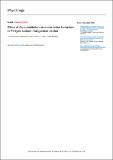Effect of Cu substitution on anion redox behaviour in P3-type sodium manganese oxides
Date
12/10/2022Author
Grant ID
ep/l017008/1
EP/R023751/1
EP/T019298/1
Metadata
Show full item recordAbstract
Sodium layered oxides which display oxygen anion redox behaviour are considered promising positive electrodes for sodium-ion batteries because they offer increased specific capacities. However, they suffer from irreversible structural changes resulting in significant capacity loss and limited oxygen redox reversibility. Here the effect of Cu substitution on the electrochemical performance of P3-type sodium manganese oxide is examined by evaluating the structural and electronic structural evolution upon cycling, supported by density functional theory (DFT) calculations. Over the voltage range 1.8–3.8 V vs. Na/Na+, where the redox reactions of the transition metal ions contribute entirely towards the charge compensation mechanism, stable cycling performance is maintained, showing a capacity retention of 90% of the initial discharge capacity of 166 mA h g−1 after 40 cycles at 10 mA g−1. Over an extended voltage range of 1.8–4.3 V vs. Na/Na+, oxygen anion redox is invoked, with a voltage hysteresis of 110 mV and a greater initial discharge capacity of 195 mA h g−1 at 10 mA g−1 is reached. Ex-situ powder x-ray diffraction patterns reveal distortion of the P3 structure to P'3 after charge to 4.3 V, and then transformation to O'3 upon discharge to 1.8 V, which contributes towards the capacity fade observed between the voltage range 1.8–4.3 V. DFT with projected density of states calculations reveal a strong covalency between the copper and oxygen atoms which facilitate both the cationic and anionic redox reactions in P3-type Na0.67Mn0.9Cu0.1O2.
Citation
Linnell , S F , Manche , A G , Liao , Y , Hirsbrunner , M , Imada , S , Naden , A B , Irvine , J T S , Duda , L & Armstrong , R 2022 , ' Effect of Cu substitution on anion redox behaviour in P3-type sodium manganese oxides ' , Journal of Physics: Energy , vol. 4 , no. 4 , 044006 . https://doi.org/10.1088/2515-7655/ac95cc
Publication
Journal of Physics: Energy
Status
Peer reviewed
ISSN
2515-7655Type
Journal article
Description
Funding information: This work was supported by the Faraday Institution (Grant No. FIRG018). The authors gratefully acknowledge support from the Engineering and Physical Sciences Research Council (EPSRC), Grant Nos. EP/L017008/1, EP/R023751/1 and EP/T019298/1.Collections
Items in the St Andrews Research Repository are protected by copyright, with all rights reserved, unless otherwise indicated.

